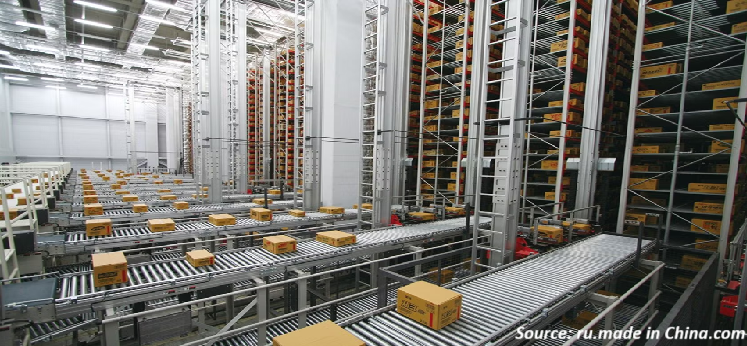
Cold Storage Market by Type (Facilities/Services and Equipment), by Temperature (Chilled, Frozen, and Deep Frozen), by Construction Type (Private Cold Storage, Public Cold Storage and Automated Cold Storage), and by Application (Dairy and Frozen Desserts, Fish, Meat and Seafood Products, Bakery and Confectionery Products, Fruit & Vegetables, Pharmaceutical, and Other Application) – Global Opportunity Analysis and Industry Forecast 2025 – 2030
US Tariff Impact on Cold Storage Market
Trump Tariffs Are Reshaping Global Business
Cold Storage Market Overview
The global Cold Storage Market size was valued at USD 159.92 billion in 2024 and is predicted to reach USD 346.07 billion by 2030 with a CAGR of 13.8% from 2025-2030. The market is growing rapidly due to the expanding food and beverage and pharmaceutical sectors, driven by increased demand for fresh, perishable goods and temperature-sensitive medical products like vaccines and biologics.
The rise of e-commerce and online grocery platforms necessitates robust cold chain logistics to maintain product quality, while the pharmaceutical industry requires stringent storage conditions to meet regulatory standards.
Technological advancements, including automated systems, IoT-enabled monitoring, and AI-driven platforms like those recently launched by industry leaders, enhance operational efficiency and sustainability.
Despite challenges from high energy and maintenance costs, the integration of AI, blockchain, and robotics presents transformative opportunities for optimizing inventory, ensuring compliance, and driving future market growth.
Rising Growth of F&B Sector Propels the Demand for Cold Storage Solutions
The food and beverage industry is one of the primary drivers of the cold storage market demand, fueled by growing consumer demand for fresh, frozen, and perishable goods, particularly through online grocery delivery channels. The rise of e-commerce has transformed consumer behavior, with online platforms prioritizing timely delivery of high-quality food products, necessitating robust cold room facilities to maintain product integrity.
According to the International Trade Administration, global business-to-consumer (B2C) e-commerce revenue is projected to grow from USD 3.6 trillion in 2023 to USD 5.5 trillion by 2027, reflecting significant growth in online food shopping. This surge is prompting businesses to invest in advanced cold storage infrastructure, such as refrigerated warehouses and last-mile delivery solutions, to meet consumer expectations for freshness and convenience.
The expansion of organized retail and quick-commerce platforms in emerging economies, such as India and China, also amplifies the need for scalable cold storage solutions to support supply chain efficiency and food safety compliance.
Increasing Demand Across Pharmaceutical Industry Propels the Market Expansion
The pharmaceutical sector significantly contributes to the cold storage market expansion, driven by the need to store temperature-sensitive products such as vaccines, biologics, and specialty drugs. These products require stringent temperature controls to maintain efficacy and ensure safe handling during storage and transportation, aligning with regulatory standards set by authorities like the U.S. Food and Drug Administration (FDA) and the European Medicines Agency (EMA).
The World Bank reports that healthcare expenditure accounted for 16.57% of GDP in the United States and 12.65% in Germany in 2023, underscoring the substantial investments in healthcare infrastructure that support cold storage demand. The rise of personalized medicine and biologics, coupled with global vaccination campaigns, has intensified the need for ultra-low-temperature storage solutions, fueling the market expansion.
Ongoing Technological Developments Expands the Market Growth
Technological innovations are revolutionizing cold storage operations, enhancing efficiency, reliability, and sustainability, and thereby driving market growth. Automated storage and retrieval systems (ASRS), Internet of Things (IoT)-enabled temperature monitoring, and energy-efficient refrigeration technologies are increasingly adopted to optimize supply chain performance.
IoT sensors provide real-time data on temperature and humidity, reducing the risk of product spoilage and ensuring compliance with food safety and pharmaceutical regulations. In April 2024, Americold Logistics, Inc. launched a state-of-the-art automated cold storage facility in Russellville, Arkansas, with a USD 90 million investment. This facility incorporates advanced automation technologies, including robotic palletizing and conveyor systems, to enhance throughput and storage capacity for temperature-sensitive products.
Similarly, the integration of smart sensors and predictive analytics enables proactive maintenance of refrigeration systems, minimizing downtime and operational costs. These advancements not only improve operational efficiency but also align with sustainability goals by reducing energy consumption, positioning technology as a critical driver of the market.
High Costs Associated with Maintaining Cold Storages Hinders the Market
The high energy consumption required to maintain low temperatures in frozen storage facilities pose a significant challenge to the cold storage market growth. Refrigeration systems, particularly those supporting ultra-low temperatures for pharmaceuticals, demand substantial electricity, leading to elevated operational costs.
Additionally, the need for continuous monitoring, regular maintenance, and compliance with stringent regulations further increases expenses. These costs can strain profitability, especially for smaller operators or facilities in regions with high energy prices. Addressing this restraint requires investments in energy-efficient technologies and renewable energy sources, which, while promising, involve upfront costs that deter adoption.
Incorporation of AI in Cold Storages Creates Future Opportunities for the Market
The integration of artificial intelligence, blockchain, and robotics into cold storage operations presents transformative opportunities for the market by enhancing efficiency, traceability, and cost management. AI-driven platforms optimize inventory management, predict demand, and mitigate risks in cold chain logistics, ensuring product quality and regulatory compliance.
In May 2024, Paxafe raised USD 9 million in Series A funding to expand its AI-driven cold chain logistics platform, which predicts and prevents temperature excursions during the transportation of perishable goods. This investment aims to enhance Paxafe’s global reach and product offerings, reflecting the growing adoption of AI in cold storage. Blockchain technology further improves supply chain transparency by creating immutable records of temperature and handling data, fostering trust among stakeholders and reducing fraud.
Additionally, in October 2024, Lineage Logistics introduced its AI-powered “Lineage Insights” platform, designed to optimize cold storage operations through predictive analytics and real-time monitoring. These innovations highlight the potential for advanced technologies to drive operational excellence and market expansion.
Market Segmentation and Scope of Study
The cold storage market report is divided on the basis of type, temperature, construction type, application and region. On the basis of type, the market is categorized into facilities/services and equipment. Facilities/services again divided into refrigerated warehouse and cold room. On the basis of temperature, the market is classified into chilled, frozen, and deep frozen. On the basis of construction type, the market is bifurcated into private storage, public storage and automated storage. On the basis of application, the market is divided into dairy and frozen desserts, fish, meat and seafood products, bakery and confectionery products, fruit & vegetables, pharmaceuticals, and other application. Regional breakdown and analysis of each of the aforesaid segments includes regions comprising of North America, Europe, Asia-Pacific, and RoW.
Geographical Analysis
North America dominates the cold storage market share and is expected to continue its dominance throughout the forecast period. This is attributed to the increased healthcare spending on temperature sensitive vaccines that drives the need for specialized cold storage to keep these products safe and effective.
As per the latest data by the World Bank, the U.S. contributed almost 16.57% of the healthcare expenditure in the GDP for the year of 2023. Moreover, in the year 2023 Canada accounted approximately 9.72 percent in the overall GDP from its healthcare expenditure. The region’s robust logistics network and high adoption of cold chain technologies further solidify North America’s position as the market leader, ensuring product integrity from production to administration.
Also, rising government investment and subsidies aimed at enhancing agricultural infrastructure and expanding cold storage facilities drives the growth of the market in North America by improving supply chain efficiency and reducing food waste.
In 2024, the U.S. government launched its largest cold storage facility to date, designed to improve food security and minimize post-harvest losses for local farmers. This initiative provides advanced storage solutions for perishable goods, such as fruits, vegetables, and dairy, enabling farmers to extend shelf life and access broader markets.
By investing in modern cold storage infrastructure, governments are addressing the challenge of food spoilage, which the Food and Agriculture Organization (FAO) estimates accounts for 14% of global food production losses. These investments not only enhance agricultural productivity but also stimulate demand for cold storage facilities, reinforcing market growth in North America and beyond.
On the other hand, Asia-Pacific region is considered fastest growing driven by rapid urbanization and the resulting surge in demand for grocery products, particularly fresh and frozen foods. Urban expansion has increased reliance on efficient cold chain logistics to deliver high-quality perishable goods to densely populated cities.
According to the UN Population Division, China’s urban population grew from 897.58 million in 2022 to 910.90 million in 2023, highlighting the rising need for advanced cold storage solutions to support urban lifestyles. This trend is mirrored in countries like India, where the growth of organized retail, quick-commerce platforms, and online grocery delivery is amplifying demand for refrigerated warehouses. The shift toward convenience foods, such as frozen meals and dairy products, further necessitates precise temperature control to ensure product freshness, driving investments in cold storage infrastructure across the region.
Additionally, key market players are actively pursuing business expansion strategies to capitalize on growing demand and strengthen their competitive positions, further propelling the industry. In March 2023, Fresh & Healthy Enterprises Limited launched India’s largest cold storage facility, equipped with specialized storage units for temperature-sensitive products like ice cream, butter, and frozen vegetables. This facility enhances supply chain efficiency by providing large-scale, multi-temperature storage capabilities, catering to the rising demand for frozen and perishable goods in India.
Similarly, global leaders like Americold and Lineage Logistics are expanding their footprints through new facilities and acquisitions to meet regional demands. These expansions not only increase storage capacity but also integrate advanced technologies, such as automated systems and IoT monitoring, to optimize operations and ensure compliance with food safety standards.
Key Strategies Adopted by Companies
Key players in the global cold storage industry are actively pursuing strategies focused on expanding capacity, enhancing sustainability, and integrating advanced technologies to capture a larger market share and address the significant growth potential in this sector.
Recent developments include the construction of state-of-the-art facilities with energy-efficient systems, the adoption of automation for improved operational efficiency, and strategic partnerships to strengthen regional supply chains. There is also a growing trend toward developing multi-temperature storage solutions capable of accommodating diverse products, such as food, beverages, and pharmaceuticals, although challenges remain in balancing high upfront costs with long-term profitability.
For instance, in February 2024, Emergent Cold Latin America invested USD 15 million to expand its temperature-controlled food storage and logistics facilities in Panama, positioning the company as the largest refrigerated food storage provider in Central America. This expansion enhances service offerings across the region, catering to the rising demand for perishable goods.
A key challenge for industry players lies in managing the high energy costs associated with maintaining precise temperature controls, as well as navigating varying regulatory standards across different regions. However, significant opportunities exist in leveraging automation, IoT-based monitoring, and renewable energy sources to improve efficiency and reduce environmental impact.
Moreover, the exploration and adoption of sustainable technologies, such as ammonia-based refrigeration and solar-powered systems, present considerable opportunities to expand the market and enhance operational resilience.
For example, in December 2023, Americold Logistics partnered with RSA Cold Chain and DP World to invest USD 35 million in a new cold storage facility in Dubai, featuring 40,000 pallet positions and multi-temperature capabilities. This facility significantly boosts storage capacity in the Middle East, supporting the food and beverage industry and improving supply chain resilience.
Similarly, in December 2023, Lineage Logistics launched an advanced cold storage facility in New Zealand with over 3 million cubic feet of space, incorporating sustainable and energy-efficient systems to enhance supply chain capabilities.
Future developments are focusing on integrating artificial intelligence (AI) for predictive logistics and optimizing facility designs based on regional demand patterns, which could further shape market trends and drive the industry growth.
Key Benefits
-
The report provides quantitative analysis and estimations of the industry from 2025 to 2030, which assists in identifying the prevailing cold storage market opportunities.
-
The study comprises a deep-dive analysis of the current and future cold storage market trends to depict prevalent investment pockets in the sector.
-
Information related to key drivers, restraints, and opportunities and their impact on the market is provided in the report.
-
Competitive analysis of the players, along with their market share is provided in the report.
-
SWOT analysis and Porters Five Forces model is elaborated in the study.
-
Value chain analysis in the market study provides a clear picture of roles of stakeholders.
Cold Storage Market Key Segments
By Type
-
Facilities/Services
-
Refrigerated Warehouse
-
Cold Room
-
-
Equipment
-
Blast freezer
-
Walk-in Cooler and Freezer
-
Deep Freezer
-
Others
-
By Temperature
-
Chilled
-
Frozen
-
Deep Frozen
By Construction Type
-
Private Cold Storage
-
Public Cold Storage
-
Automated Cold Storage
By Application
-
Dairy and Frozen Desserts
-
Fish, Meat and Seafood Products
-
Bakery and Confectionery Products
-
Fruit & Vegetables
-
Pharmaceuticals
-
Other Application
By Region
-
North America
-
The U.S.
-
Canada
-
Mexico
-
-
Europe
-
The UK
-
Germany
-
France
-
Italy
-
Spain
-
Denmark
-
Netherlands
-
Finland
-
Sweden
-
Norway
-
Russia
-
Rest of Europe
-
-
Asia-Pacific
-
China
-
Japan
-
India
-
South Korea
-
Australia
-
Indonesia
-
Singapore
-
Taiwan
-
Thailand
-
Rest of Asia-Pacific
-
-
Rest of the World
-
Latin America
-
Middle East
-
Africa
-
Key Players
-
Lineage, Inc.
-
Americold Logistics, Inc.
-
United States Cold Storage Inc.
-
NewCold Coöperatief U.A.
-
Nichirei Logistics Group, Inc.
-
Emergent Cold LatAm Management LLC
-
Constellation Cold Logistics Sarl
-
Frialsa Frigorificos S.A. De C.V.
-
Tippmann Group Company
-
FreezPak Logistics
-
SSC Schaffer
-
Celcius Logistics
-
Coldman Group
-
A.P. Moller Maersk
-
Antes Global
REPORT SCOPE AND SEGMENTATION:
|
Parameters |
Details |
|
Market Size in 2024 |
USD 159.92 Billion |
|
Revenue Forecast in 2030 |
USD 346.07 Billion |
|
Growth Rate |
CAGR of 13.8% from 2025 to 2030 |
|
Analysis Period |
2024–2030 |
|
Base Year Considered |
2024 |
|
Forecast Period |
2025–2030 |
|
Market Size Estimation |
Billion (USD) |
|
Growth Factors |
|
|
Countries Covered |
28 |
|
Companies Profiled |
15 |
|
Market Share |
Available for 10 companies |
|
Customization Scope |
Free customization (equivalent to up to 80 working hours of analysts) after purchase. Addition or alteration to country, regional, and segment scope. |
|
Pricing and Purchase Options |
Avail customized purchase options to meet your exact research needs. |

















 Speak to Our Analyst
Speak to Our Analyst





















